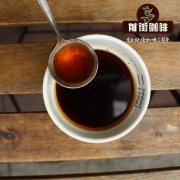Brazilian Santos Coffee introduction Brazilian Santos Coffee Flavor introduction Brazilian Coffee hand pulping parameters

Professional coffee knowledge exchange more coffee bean information please follow the coffee workshop (Wechat official account cafe_style)
Brazil, currently the world's largest coffee producer, accounts for about 1/3 of the world's total output. There are 26 states and 1 federal district in the country, and 17 states produce coffee, of which four states, including Parana, Sao Paulo, Minas Gerais and Espirito Santo, account for 98% of the country's total output.
Unlike the general environment in which coffee beans grow, Brazilian coffee is grown at lower elevations and grows directly in the sun to make coffee beans grow faster. The vast majority of Brazilian coffee is sun-dried rather than washed, with a moderate taste, smooth into the throat, low bitterness and an unforgettable sweet aftertaste, which is suitable for mixing with other coffees.
Brazil not only produces coffee, but also loves coffee to the extreme. Each of them drinks an average of 1200 cups of coffee a year, with a capacity of 50 to 80 milliliters per cup, making it the second largest coffee consumer in the world after the United States. For the first meal of the day, Brazilians call breakfast "morning coffee" (cafe da manha) even if they don't drink coffee.
The most famous Brazilian coffee is "Santos Coffee" produced in the state of Sao Paulo. Located in the southeastern state of Sao Paulo, the capital city of Sao Paulo (Sao Paulo), in addition to being the largest city in Brazil, with a population of more than 11 million, it is also the largest city in the southern hemisphere. Local people are used to calling it "paulistano". During the 19th century, the city of Sao Paulo became the richest city in South America because of its coffee export trade through the "Port of Santas".
The famous "Santos Coffee" is named after Santos, the outer port of Sao Paulo.
Santos coffee is produced by Coffee Arabica's Bourbon, so it is also known as "Bourbon Santos". Its neutral taste, warm and mellow taste, moderate acidity and concentration, elegant flavor, conquers the taste buds of many coffee lovers, and is regarded as the backbone of coffee. It can be drunk alone or mixed with other coffee beans to form a comprehensive coffee.
Suggestion of hand punching parameters: filter cup KONO, grind degree small Fuji 4 scale, water temperature 88 °, powder / water ratio 1 / 14 14g / 15g powder 225g water, total cooking time 2 minutes.
Important Notice :
前街咖啡 FrontStreet Coffee has moved to new addredd:
FrontStreet Coffee Address: 315,Donghua East Road,GuangZhou
Tel:020 38364473
- Prev

Flavor characteristics of G1 washed beans in Cochel treatment Plant, Yega Feikochel Town, Ethiopia
Professional coffee knowledge exchange more coffee bean information please follow the coffee workshop (Wechat official account cafe_style) Ethiopia washed Yega Feikochel town Corey processing plant G1 washed bean flavor characteristics and growing environment? (Ethiopia Washed Yirgacheffe Kochere Kore G1) producing area: Yirgacheffe (Yirgacheffe) Kochel (Kochere) producing area
- Next

How about Ugandan coffee? Uganda coffee flavor Uganda coffee hand brewing parameters
Professional coffee knowledge exchange more coffee bean information please follow coffee workshop (Wechat official account cafe_style) Uganda is a country with dense green forests, lakes, wetlands and rivers rich in water resources, coffee is the largest crop in Uganda to earn the most foreign exchange, there are about 500000 coffee farms engaged in coffee-related agriculture accounting for 25% of the total population, coffee trees are large
Related
- Detailed explanation of Jadeite planting Land in Panamanian Jadeite Manor introduction to the grading system of Jadeite competitive bidding, Red bid, Green bid and Rose Summer
- Story of Coffee planting in Brenka region of Costa Rica Stonehenge Manor anaerobic heavy honey treatment of flavor mouth
- What's on the barrel of Blue Mountain Coffee beans?
- Can American coffee also pull flowers? How to use hot American style to pull out a good-looking pattern?
- Can you make a cold extract with coffee beans? What is the right proportion for cold-extracted coffee formula?
- Indonesian PWN Gold Mandrine Coffee Origin Features Flavor How to Chong? Mandolin coffee is American.
- A brief introduction to the flavor characteristics of Brazilian yellow bourbon coffee beans
- What is the effect of different water quality on the flavor of cold-extracted coffee? What kind of water is best for brewing coffee?
- Why do you think of Rose Summer whenever you mention Panamanian coffee?
- Introduction to the characteristics of authentic blue mountain coffee bean producing areas? What is the CIB Coffee Authority in Jamaica?

